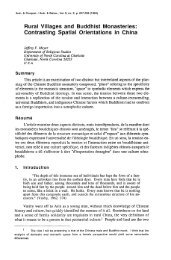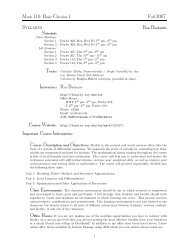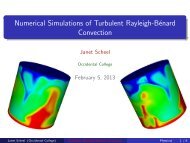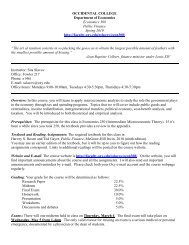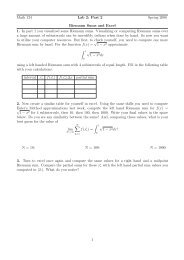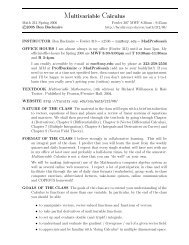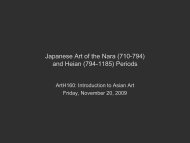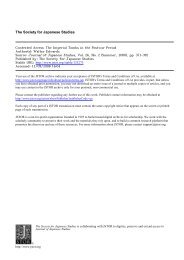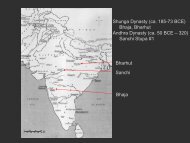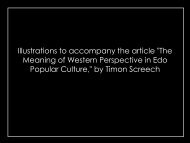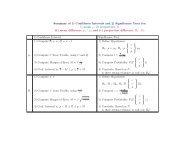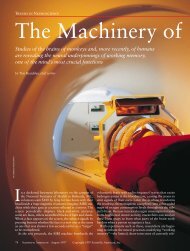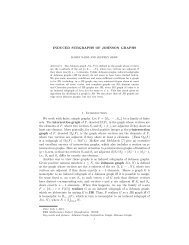A Primer on Japanese Hell Imagery and Imagination - Occidental ...
A Primer on Japanese Hell Imagery and Imagination - Occidental ...
A Primer on Japanese Hell Imagery and Imagination - Occidental ...
Create successful ePaper yourself
Turn your PDF publications into a flip-book with our unique Google optimized e-Paper software.
30<br />
M<strong>on</strong>umenta Nipp<strong>on</strong>ica 63:1<br />
based <strong>on</strong> karma into <strong>on</strong>e that is an embodiment of enlightenment. The text explains<br />
that the sp<strong>on</strong>taneous, eternal triune Buddha body (musa no sanjin<br />
), encompassing everything, is identical to the three shitchi, to Abi hell, <strong>and</strong><br />
to the highest realizati<strong>on</strong>s of buddhahood. Enlightened underst<strong>and</strong>ing of this<br />
unfailingly tears hell. Such underst<strong>and</strong>ing, the text explains, has both exoteric<br />
<strong>and</strong> esoteric aspects.<br />
In an “exoteric” comprehensi<strong>on</strong>, c<strong>on</strong>templati<strong>on</strong> of the heart enables the realizati<strong>on</strong><br />
that all of the dharma world is Birushana’s (Sk. Vairocana) envir<strong>on</strong>ment<br />
<strong>and</strong> body (eshô ) <strong>and</strong> that hell is located in the Buddha’s heart. 111<br />
The esoteric approach expresses this underst<strong>and</strong>ing through ritual practice (phenomena).<br />
<strong>Hell</strong> is Dainichi’s (Sk. Mahâvairocana) Pure L<strong>and</strong> of the Diam<strong>on</strong>d<br />
<strong>and</strong> Womb worlds, <strong>and</strong> the m<strong>and</strong>ala is in our hearts. Keiran shû supports the<br />
latter underst<strong>and</strong>ing with the medieval logic of analogy, borrowing ideas from<br />
established esoteric c<strong>on</strong>cepti<strong>on</strong>s. Our nine shiki (“c<strong>on</strong>sciousnesses”), the text<br />
explains, are the eight petals <strong>and</strong> nine divinities of the Womb m<strong>and</strong>ala—each<br />
petal c<strong>on</strong>taining a buddha or bodhisattva, with Dainichi at the center, adding up<br />
to a total of nine. The circular Jôhari mirror in the center of hell is our ninth shiki,<br />
which is the heart’s mo<strong>on</strong>-like (mirror-like) orb, also equated with Dainichi.<br />
Eight other mirrors in Enma’s kingdom are aligned with the other eight shiki <strong>and</strong><br />
the other eight divinities of the flower platform. 112 Through c<strong>on</strong>templati<strong>on</strong>, the<br />
m<strong>and</strong>ala world <strong>and</strong> hell are thus equated with the heart <strong>and</strong> shiki of the practiti<strong>on</strong>er.<br />
Furthermore, the l<strong>and</strong>scape of the eight hot hells is c<strong>on</strong>joined with the<br />
Womb world <strong>and</strong> principle, <strong>and</strong> the l<strong>and</strong>scape of the eight cold hells linked to<br />
the Diam<strong>on</strong>d world <strong>and</strong> wisdom. 113 The passage c<strong>on</strong>cludes that if hell is the Pure<br />
L<strong>and</strong> of the universal Buddha Dainichi’s two worlds, the living beings in hell<br />
are the sp<strong>on</strong>taneous, eternal Buddha-body trinity. When <strong>on</strong>e underst<strong>and</strong>s this,<br />
Keiran shû asserts, there is no hell that cannot be torn.<br />
The more complicated doctrines <strong>and</strong> rituals described above tended to remain<br />
the c<strong>on</strong>cern of Buddhist intellectuals <strong>and</strong> practiti<strong>on</strong>ers, but certain principles<br />
were also taught to lay believers through images called End<strong>on</strong> kanjin jippôkai<br />
zu<br />
. C<strong>on</strong>solidating <strong>and</strong> simplifying doctrines in graphic form,<br />
these portrayed inhabitants of the ten worlds emanating from the character for<br />
heart or mind (shin ), illustrating the Tiantai doctrine that the entire universe<br />
111 This underst<strong>and</strong>ing is based <strong>on</strong> the Tiantai doctrines of ichinen sanzen (“the three<br />
thous<strong>and</strong> worlds in <strong>on</strong>e thought”) <strong>and</strong> isshin sangan (“c<strong>on</strong>templati<strong>on</strong> of emptiness, phenomena,<br />
<strong>and</strong> their balance in <strong>on</strong>e heart-mind”). The text also references the eighth-century Tiantai<br />
m<strong>on</strong>k Zhanran’s Jinpi lun (Jp. K<strong>on</strong>bei r<strong>on</strong>; also Jingangpi , Jp. K<strong>on</strong>gôbei); T<br />
46:781a.<br />
112 On c<strong>on</strong>necti<strong>on</strong>s in the Podiyu yigui hell-tearing text between the nine shiki (the ninth being<br />
amarashiki ), the nine-layered mo<strong>on</strong> rings, <strong>and</strong> the eight petals <strong>and</strong> nine divinities of the<br />
Womb m<strong>and</strong>ala, see T 18:913c–914a; <strong>and</strong> Misaki 1988, pp. 505–507. Also see the descripti<strong>on</strong> of<br />
the Jôhari <strong>and</strong> eight other karma mirrors in Jizô jûô kyô, p. 771.<br />
113 Keiran shû uses the words mitsug<strong>on</strong> <strong>and</strong> kezô , which in <strong>Japanese</strong> esoteric thought<br />
refer to the two worlds. See Horiuchi 2000.



